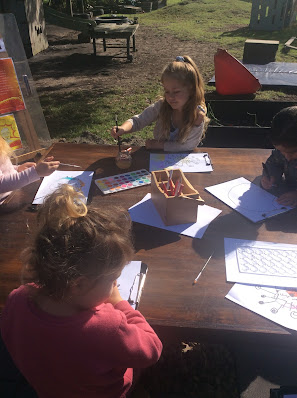The exact moment of understanding captured in a photograph!
Notice how the eyes sparkle with wonder and delight...it's an exhilarating moment of deep understanding, both joyous and precious.
With the minuet touching of the yellow dye to the blue dye, tamariki make the connection that blue and yellow make green!
Of course anyone could have told the children this, however this would have taken all the joy out of learning. It's the experience that makes the difference of deeper knowledge and understanding, and this is the same for learning!
There's something about seeing with your own eyes, experiencing it through your own senses and actions, that makes learning so much deeper, more meaningful and more memorable. It's the equivalent of someone telling you that chocolate cake tastes good, and eating chocolate cake and knowing that chocolate cake tastes really good.
So how did learning happen? Lets take a look...
Following our Matariki celebrations, teachers had set out some paint on large paper hoping for children to get creative and talk about the Fire Poi experience we'd had down at the beach.
What began as conversations about fire poi, ended in excitement over paint changing colour. Children were in awe of the way the paints mixed to form new colours and asked how this was happening. They couldn't believe their eyes!
Teachers recognized an opportunity for deeper exploration of colour and set out a number of different play experiences for children to experiment with.
Exploring yellow and red.
Mixing yellow and blue.

Exploring colour outside...



Thinking up different ways for children to explore new concepts is the never ending goal of teachers. The question, do you want to see something magic sparked children's initial curiosity and engagement, and provided the perfect opportunity to keep learning happening.
Watching the yellow dye race up the paper towel to meet the blue on the other side was exciting stuff. Watching the yellow and blue turn to green just magical.
A new version of the game...what would happen adding red?
It's exciting stuff!
Being surprised!
Trying to work it all out.
Learning about colour could take a lifetime and we had fun in this beginning exploration. I wonder what colour explorations we'll try next?!
Thanks for joining us.
The team at Bream Bay Kindergarten






























































%201.png)






































